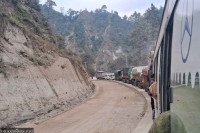Editorial
What good is it?
The High Level Political Mechanism has not been able to solve any pressing problem.
It has a self-important name, alright. But is the High Level Political Mechanism of any use? Worse, is it actually causing more harm than good? The body, headed by KP Sharma Oli, chair of CPN-UML, the largest party in the ruling coalition—and comprising the leaders of the seven parties that support the ruling coalition—recently convened a couple of meetings. But not everyone was on board. The Rastriya Prajatantra Party chair Rajendra Lingden, who is also deputy prime minister and energy minister in the present Cabinet, said coalition leaders on Sunday agreed to hold regular meetings and to make the body more effective. But the chiefs of three parties have been conspicuously absent from such gatherings. While Prime Minister Pushpa Kamal Dahal, UML chair Oli, Rastriya Swatantra Party President Rabi Lamichhane and RPP chair Lingden have been present in recent meetings, Upendra Yadav of Janata Samajbadi Party, CK Raut of Janamat Party and Ranjita Shrestha of Nagarik Unmukti are routinely absent.
The latter three have been boycotting the mechanism’s meetings as they are unhappy with the big parties over being left out in power-sharing and for ignoring their demands. Likewise, while Oli has been keen on keeping the body active, Prime Minister Dahal seems unsure. The concept of such a high-level political entity is not new in Nepal. The problem is that they seldom work. Historically, they are formed amid great mistrust. Prime ministers don’t tend to trust an extra-legal body that they see as working in parallel with the government. They reckon the one and only goal of the body is to hamper their functioning every step of the way. Indeed, coalition partners often force the head of the government, who is bound by the constitution, to take certain unpalatable decisions via such a mechanism.
Ironically, the body that is supposed to clear misunderstandings has itself become a reason for suspicion among coalition partners. There are also no instances of the body resolving complex political issues and playing an instrumental role in government functioning. Also, the use of such a mechanism differs according to whom you ask. Some leaders take it as a consultative political platform while others describe it as an advisory or facilitative body. General Secretary of CPN (Maoist Centre) Dev Gurung thinks this is just another political forum for discussion, and is no different to the all-party meeting the prime minister convenes to seek suggestions on key political issues.
UML leaders seem to believe that having such a mechanism is vital to articulate and make the prime minister aware of the demands of coalition partners. Yet everything about the mechanism is vague. It does not seem to have a fixed secretariat, nor a record of its expenses. Most importantly, what is the validity of its decisions? For any such mechanism to work, its constituents should be clear about its role, responsibilities and jurisdiction. Otherwise, the mechanism will, rightly or wrongly, be seen as no more than a place for petty politics where coalition partners take potshots at one another. In other words, its dysfunction will only add to people’s growing doubts over the intent of our top political leaders. A fancy name won’t do it much good in that case.




 13.98°C Kathmandu
13.98°C Kathmandu














